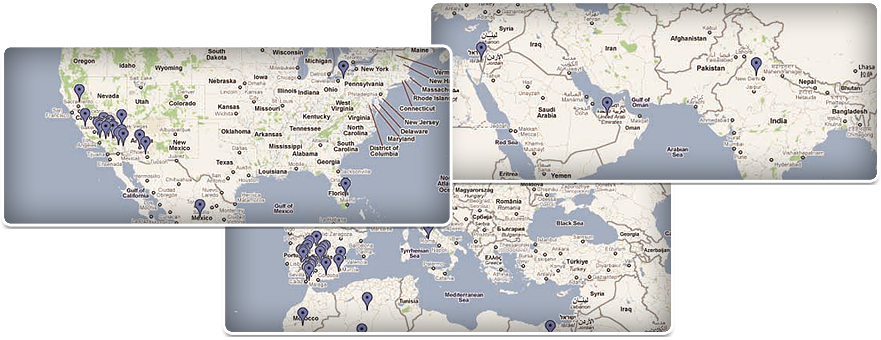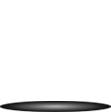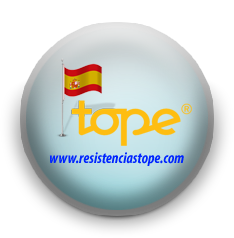





Resistencias Tope S.A. is a company with over 50 years of experience in development and manufacturing of custom made heating elements. The following are examples of our products and different applications: where their find their use. Heater for different kinds of fluid (corrosive or non-corrosive), heaters for ATEX Ex hazardous environments, large tank heaters, ambience and comfort heaters, industrial and drying heaters, zamack extrusion heaters, plastic processing heaters, etc. Our technical department will help you developing quickly efficient solutions for your heating system.

 Resistencias Tope products are developed and
manufactured in accordance with European
Directives.
Resistencias Tope products are developed and
manufactured in accordance with European
Directives.
 Resistencias Tope products are developed and
manufactured in accordance with USA Directives.
Resistencias Tope products are developed and
manufactured in accordance with USA Directives.
 Quality system is certified in accordance with
standard UNE EN ISO 9001:2008.
Quality system is certified in accordance with
standard UNE EN ISO 9001:2008.
 EC Directive regulating equipment and protective
systems intended for use in potentially
explosive atmospheres.
ATEX certification approved for all type of gas
and dust to suit zone 1, zone 21 and zone 22.
(Ex d IIC & Ex t IIIC)
EC Directive regulating equipment and protective
systems intended for use in potentially
explosive atmospheres.
ATEX certification approved for all type of gas
and dust to suit zone 1, zone 21 and zone 22.
(Ex d IIC & Ex t IIIC)
 ASME-"U" ASME VIII div.1 and div.2-ASME "U"
Stamp.Certification for pressurized vessels
manufactured in carbon steel and stainless steel.
ASME-"U" ASME VIII div.1 and div.2-ASME "U"
Stamp.Certification for pressurized vessels
manufactured in carbon steel and stainless steel.
 PED 97/23/EC.
EC Directive for pressurized vessels manufactured
in carbon steel and stainless steel.
PED 97/23/EC.
EC Directive for pressurized vessels manufactured
in carbon steel and stainless steel.
From the beginning we have developed a high level of
solutions for different sectors:
engineering, aeronautical, chemical, pharmaceutical,
ATEX areas, food, plastics,automotive,…





This big experience on all this sectors push us to develop together with big engineering companies the electrical heating systems used in plants distributed all over the world.

Tope manufactures heating elements that are installed in many different applications. This heating elements can reach temperatures from 80ºC till 800ºC





- HEATING FUNDAMENTAL
- ELECTRICAL HEATING DESIGN
- Step 1: Establish Design Parameters
- Step 2: Determine Heat up power and Heat Losses
- Step 3: Design the heater
- Step 4: Control Selection
- INSTALLATION
- Most industrial facilities will have electrical power available
- A variety of types and methods of electric heating may be used to maintain a broad range of temperatures for process systems and associated equipment.
- The advantages of electricity include better controllability, no emissions and low capital equipment cost
- Simplified installation and reduced operation and maintenance costs.
- Over its history, electric tracing has proven to be a safe choice for process systems and equipment heating.
ELECTRICAL HEATING ADVANTAGE
- ELECTRICAL HEATING DESIGN
- Step 1: Establish Design Parameters
Tank/ Process details
- of the Tank
- Medium to be heated
- Mass or Flow Dimensions
Temperature
- Min and Max Ambient Temperature
- Start-up Temperature
- Final Temperature
- Time required to reach Final Temperature
Electrical
- Electrical area classification
- Circuit Breaker capacity
- Operating Voltage
Tank’s Insulation
- Type
- Thickness
- Step 2: Determine Heat up power and Heat Losses


- SAFETY FACTOR CONSIDERATIONS (1,2)
- Thermal insulation degradation
- Supply voltage variations
- Branch wiring voltage drop
- Heating device voltage drop (if applicable)
- Increased radiation and convection on higher temperature applications
- Quality of installation of thermal insulation
- Step 3: Design the heater
- SELECT THE PROPER MATERIALS FOR THE DESIGN
In order to determine the correct materials to the application the following information will be necessary
- -Working temperature
- -Max. exposure temperature
- -Material of the Vessel or Tank
- -Supply voltage
- -Chemical environment
- -Area classification
- -Heat requirement
- SELECT THE PROPER SHEATH MATERIAL FOR THE DESIGN
AISI 304
In water or humid environment max. 450°C. In air max. 700°C.
Scaling temperature: 850°C.
For food industry.
AISI 321
n water or humid environment max. 550°C.
In air max. 750°C.
Scaling temperature: 850°C.
Tube for washing and cooking heating elements.
AISI 316L
Equivalent to AISI 316, with addition of molybdenum. Besides improving resistance to corrosion and under tension, there is a better response to general corrosion. In water or corrosive humid environment max. 450°C. For food industry.
Incoloy 800
In water and air with max. Temperatures of 1050°C. Annealing temperature of heating element 1100°C.
Incoloy 825
In air for max. Temperatures up to 1100°C. In water or highly corrosive environments.
Inconel 600
Finer refractory alloy with excellent resistance to corrosion. In air up lo 1250°C.
- Design the Flange Heater
We design a bespoke heater for the customer’s application according to the size of the tank.

- Design the CIRCULATION Heater
We design a bespoke heater for the customer's application according to the space available on site

- Step 4: Control Selection
- Standard applications when accuracy is not very important (±10ºC).
Temperature control is accomplished by one of two methods :
Control Thermostats
Used for :
- PT100 sensors or Thermocouples(Type J,K)
- Process maintenance applications where The process temperature must be controlled Within a moderate or narrow band.
- INSTALLATION
- Easy Installation of our systems, “plug & play”
- A manual for installation, operating and maintenance is always supplied
Used for :




















